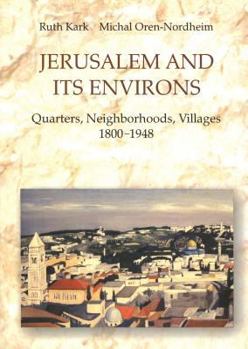Jerusalem and Its Environs: Quarters, Neighborhoods, Villages, 1800-1948
This is an illustrated account of the urban and rural development of Jerusalem from the early 19th century when Ottoman Jerusalem was encompassed by its sixteenth century walls, and was divided into quarters and courtyard units of its various religious and ethnic groupings, to the end of the Mandate period in the mid 20th century. The seeds of the current situation in Jerusalem were sown at that time. It traces the city's interaction with its rural hinterland until the establishment of the State of Israel in 1948 when Jerusalem was divided into two--the Jewish quarter of the Old City and some Jewish neighborhoods and villages were occupied by Arabs, while Jews occupied a number of Arab neighborhoods and villages. The book reconstructs and analyzes processes of establishing a variety of new types of Arab Muslim and Christian, Jewish and European Christian neighborhoods--built as community housing, extended family neighborhoods, commercial neighborhoods, and laborers' and garden suburbs. It covers the construction of institutional complexes, the introduction of significant changes in Jerusalem's administration, the creation of new planning frameworks, the planning of new settlements around the city, the concentration of large tracts of agricultural land by Jerusalem's Arab effendis, and the development of the Arab and Jewish villages in the rural hinterland.
Format:Hardcover
Language:English
ISBN:0814329098
ISBN13:9780814329092
Release Date:January 2001
Publisher:Magnes Press
Length:444 Pages
Weight:1.90 lbs.
Dimensions:1.2" x 7.0" x 9.7"
Related Subjects
HistoryCustomer Reviews
0 rating





